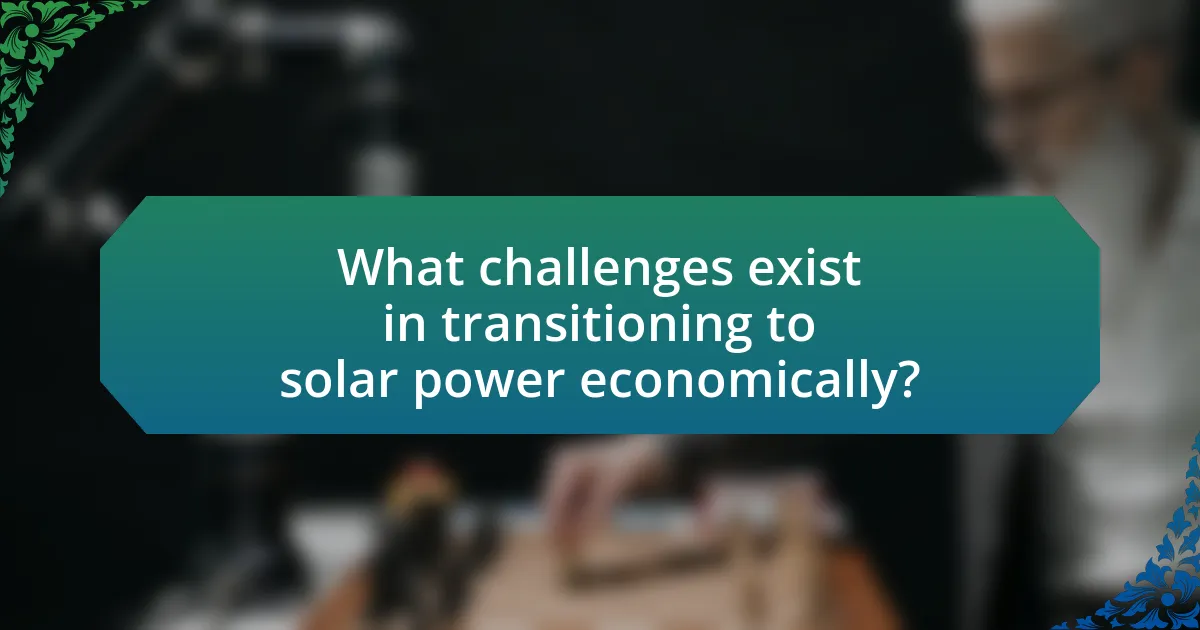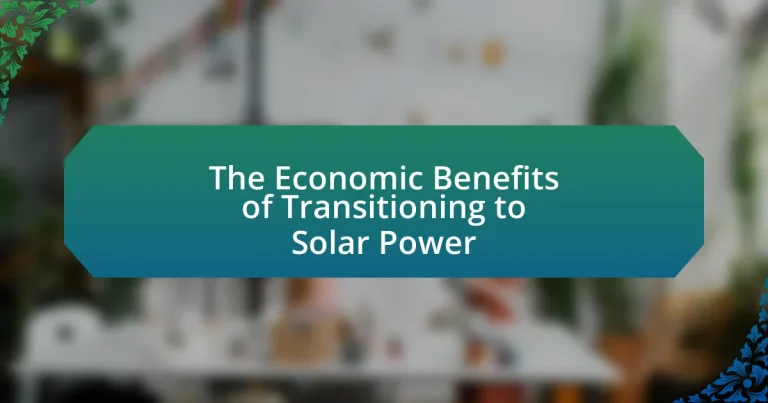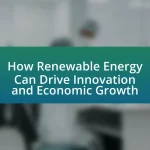The article focuses on the economic benefits of transitioning to solar power, highlighting key advantages such as reduced energy costs, job creation, and increased energy independence. It details how solar energy can lead to significant long-term savings for households and businesses, with average savings of $20,000 to $30,000 over 20 years. The solar industry is also a major job creator, employing over 250,000 workers in the U.S. as of 2021, with projections for continued growth. Additionally, the article discusses the impact of solar incentives and rebates on financial outcomes, the positive effects on local economies, and the broader implications for energy independence and environmental sustainability.

What are the Economic Benefits of Transitioning to Solar Power?
Transitioning to solar power provides significant economic benefits, including reduced energy costs, job creation, and increased energy independence. By harnessing solar energy, households and businesses can lower their electricity bills, as solar panels can significantly decrease reliance on grid power. According to the Solar Energy Industries Association, the average solar installation can save homeowners approximately $20,000 over 20 years.
Additionally, the solar industry has become a major job creator, employing over 250,000 workers in the United States alone as of 2021, with growth projected to continue as demand for renewable energy rises. This job creation contributes to local economies and stimulates further investment in related sectors.
Moreover, transitioning to solar power enhances energy independence by reducing reliance on fossil fuels, which can be subject to volatile market prices. This stability can lead to more predictable energy costs for consumers and businesses alike. Overall, the economic benefits of solar power transition are substantial and multifaceted, contributing to long-term financial savings and job growth.
How does transitioning to solar power impact overall energy costs?
Transitioning to solar power significantly reduces overall energy costs. By harnessing sunlight, which is free and abundant, households and businesses can lower their reliance on expensive fossil fuels and grid electricity. According to the U.S. Department of Energy, solar energy can lead to savings of 50% or more on electricity bills over time, especially as installation costs continue to decline. Additionally, the levelized cost of solar energy has dropped by 89% since 2009, making it one of the most cost-effective energy sources available. This shift not only provides immediate financial relief but also protects consumers from fluctuating energy prices in the long term.
What are the long-term savings associated with solar energy adoption?
Long-term savings associated with solar energy adoption include reduced electricity bills, tax incentives, and increased property value. Homeowners can save an average of $20,000 to $30,000 over 20 years on electricity costs, depending on local energy prices and solar system size. Additionally, federal tax credits, such as the Investment Tax Credit (ITC), allow for a deduction of 26% of the installation costs, further enhancing savings. Studies indicate that homes with solar panels sell for about 4.1% more than comparable homes without solar, translating to an increase in property value. These financial benefits demonstrate the economic advantages of transitioning to solar power.
How do solar incentives and rebates affect financial outcomes?
Solar incentives and rebates significantly enhance financial outcomes for homeowners and businesses adopting solar energy. These financial mechanisms reduce the upfront costs of solar installations, making them more accessible and attractive. For instance, the federal solar tax credit allows individuals to deduct a percentage of the installation costs from their federal taxes, which can amount to thousands of dollars in savings. Additionally, state and local rebates can further lower costs, with some states offering incentives that cover up to 50% of installation expenses. Research from the National Renewable Energy Laboratory indicates that these incentives can lead to a return on investment of 20% or more, depending on local energy prices and available incentives. Thus, solar incentives and rebates play a crucial role in improving the financial viability of solar energy projects.
What job creation opportunities arise from the solar industry?
The solar industry creates numerous job opportunities across various sectors, including manufacturing, installation, maintenance, and research and development. Specifically, the U.S. solar industry employed over 250,000 workers in 2021, with job growth projected to continue as solar energy adoption increases. Roles such as solar panel installers, engineers, and project managers are in high demand, driven by the expansion of solar farms and residential installations. Additionally, the industry supports jobs in supply chain management and sales, contributing to local economies and fostering sustainable employment growth.
How many jobs are generated per megawatt of solar power installed?
On average, approximately 5 to 7 jobs are generated per megawatt of solar power installed. This figure is supported by the National Renewable Energy Laboratory, which indicates that solar energy projects create a significant number of jobs during both the installation and maintenance phases. The job creation is attributed to various roles, including installation technicians, engineers, and support staff, contributing to the overall economic benefits of transitioning to solar power.
What types of jobs are most prevalent in the solar sector?
The most prevalent jobs in the solar sector include solar photovoltaic (PV) installers, solar project developers, and solar sales representatives. Solar PV installers are responsible for the installation and maintenance of solar panels, which is a rapidly growing field due to increasing solar adoption; the U.S. Bureau of Labor Statistics projects a 61% job growth for this role from 2019 to 2029. Solar project developers manage the planning and execution of solar projects, ensuring they meet regulatory requirements and are completed on time. Solar sales representatives focus on selling solar energy systems to residential and commercial customers, contributing to the sector’s expansion as awareness of renewable energy benefits increases. These roles collectively support the solar industry’s growth and the transition to sustainable energy sources.
How does solar power contribute to local economies?
Solar power contributes to local economies by creating jobs, increasing local tax revenues, and reducing energy costs for residents and businesses. The solar industry has been a significant source of employment; for instance, the Solar Foundation’s National Solar Jobs Census reported over 250,000 solar jobs in the United States as of 2019, reflecting a 167% increase since 2010. Additionally, solar installations generate property tax revenue for local governments, which can be reinvested into community services. Furthermore, by lowering electricity bills through renewable energy sources, solar power enhances disposable income for households and businesses, stimulating local spending and economic growth.
What is the impact of solar energy on property values?
The impact of solar energy on property values is generally positive, with homes equipped with solar panels often selling for higher prices compared to similar homes without them. A study by the Lawrence Berkeley National Laboratory found that, on average, solar panels increase a home’s value by about $15,000. This increase is attributed to lower energy costs and the growing demand for sustainable living options among homebuyers. Additionally, properties with solar energy systems tend to sell faster, indicating a strong market preference for energy-efficient homes.
How does solar power influence local business growth?
Solar power positively influences local business growth by reducing energy costs and enhancing sustainability. Businesses that adopt solar energy can significantly lower their electricity expenses, allowing them to allocate more resources toward expansion and innovation. For instance, a study by the National Renewable Energy Laboratory found that commercial solar installations can save businesses up to 75% on energy bills over time. Additionally, utilizing solar power can improve a company’s public image, attracting environmentally conscious consumers and investors. This shift not only fosters local job creation in the solar industry but also stimulates economic activity within the community, as businesses reinvest their savings into local operations and services.

What are the broader economic implications of solar power adoption?
The broader economic implications of solar power adoption include job creation, energy cost savings, and increased energy independence. Job creation is significant, with the solar industry employing over 250,000 workers in the United States alone as of 2021, reflecting a growth rate of 20% annually. Energy cost savings arise from reduced reliance on fossil fuels, leading to lower electricity bills for consumers; studies indicate that solar energy can reduce energy costs by 50% over time. Increased energy independence is achieved as countries invest in domestic solar infrastructure, reducing vulnerability to global energy market fluctuations. These factors collectively contribute to economic growth and stability, enhancing local economies and promoting sustainable development.
How does solar energy affect energy independence and security?
Solar energy enhances energy independence and security by reducing reliance on imported fossil fuels. By harnessing solar power, countries can generate their own electricity, which decreases vulnerability to geopolitical tensions and price fluctuations associated with oil and gas markets. For instance, in 2020, the U.S. saw a significant increase in solar capacity, contributing to a 20% reduction in energy imports, thereby bolstering national energy security. Additionally, solar energy systems can be deployed at various scales, from residential rooftops to large solar farms, allowing for localized energy production that further strengthens resilience against supply disruptions.
What role does solar power play in reducing reliance on fossil fuels?
Solar power significantly reduces reliance on fossil fuels by providing a renewable energy source that can replace traditional energy generation methods. As solar energy systems harness sunlight to produce electricity, they decrease the demand for fossil fuel-based power generation, which is responsible for greenhouse gas emissions and environmental degradation. According to the International Energy Agency, solar power capacity has grown exponentially, reaching over 800 gigawatts globally by 2020, demonstrating its potential to displace fossil fuel usage in the energy sector. This transition not only mitigates climate change impacts but also enhances energy security and stability by diversifying energy sources.
How can solar energy mitigate the effects of energy price volatility?
Solar energy can mitigate the effects of energy price volatility by providing a stable and predictable source of electricity, reducing dependence on fossil fuels whose prices fluctuate due to market dynamics. The integration of solar power into the energy mix allows consumers and businesses to lock in energy costs through long-term contracts or self-generation, which insulates them from sudden price spikes in conventional energy markets. For instance, the U.S. Energy Information Administration reported that solar energy costs have decreased by over 80% since 2010, making it a more economically viable option that can stabilize energy expenses. Additionally, solar energy systems can be deployed at various scales, enabling localized energy production that further diminishes reliance on centralized, price-volatile energy sources.
What are the environmental economic benefits of solar power?
The environmental economic benefits of solar power include reduced greenhouse gas emissions and lower energy costs. Solar power systems generate electricity without emitting carbon dioxide, which significantly contributes to mitigating climate change. According to the U.S. Environmental Protection Agency, transitioning to solar energy can reduce emissions by approximately 90% compared to fossil fuels. Additionally, solar power can lead to lower electricity bills for consumers; the National Renewable Energy Laboratory reports that homeowners can save an average of $20,000 over 20 years by installing solar panels. These savings, combined with the environmental benefits, highlight the economic advantages of adopting solar energy.
How does solar energy reduce healthcare costs associated with pollution?
Solar energy reduces healthcare costs associated with pollution by decreasing air pollutants that contribute to respiratory and cardiovascular diseases. Transitioning to solar power minimizes reliance on fossil fuels, which are major sources of harmful emissions such as sulfur dioxide and nitrogen oxides. According to a study by the National Renewable Energy Laboratory, the widespread adoption of solar energy could prevent thousands of premature deaths and reduce healthcare costs by billions annually due to improved air quality. This reduction in pollution directly correlates with lower incidences of health issues, thereby decreasing the financial burden on healthcare systems.
What is the economic value of reducing carbon emissions through solar power?
The economic value of reducing carbon emissions through solar power is significant, estimated to be in the range of $3.5 trillion to $7 trillion globally by 2050. This value arises from various factors, including reduced healthcare costs due to improved air quality, decreased climate change mitigation expenses, and enhanced energy security. For instance, a study by the International Renewable Energy Agency (IRENA) highlights that transitioning to solar power can lead to savings of approximately $1.2 trillion in health-related costs by 2030, as cleaner air results in fewer respiratory and cardiovascular diseases. Additionally, the deployment of solar energy technologies creates jobs, with the solar sector employing over 3 million people worldwide as of 2021, further contributing to economic growth.

What challenges exist in transitioning to solar power economically?
Transitioning to solar power economically faces several challenges, primarily high initial capital costs and the need for substantial infrastructure investment. The installation of solar panels and associated systems can require significant upfront expenditure, which can deter both individuals and businesses from making the switch. According to the International Renewable Energy Agency, the average cost of solar photovoltaic systems was approximately $1,000 per installed kilowatt in 2020, which can be a barrier for many potential adopters. Additionally, the variability of solar energy production necessitates investment in energy storage solutions and grid upgrades to ensure reliability, further increasing costs. These economic hurdles can slow the adoption of solar power despite its long-term cost-saving potential and environmental benefits.
What are the initial costs associated with solar power installation?
The initial costs associated with solar power installation typically range from $15,000 to $25,000 for a residential system, depending on factors such as system size, equipment quality, and installation complexity. This cost includes solar panels, inverters, mounting hardware, and installation labor. According to the National Renewable Energy Laboratory, the average cost of solar photovoltaic systems has decreased by about 70% since 2010, making solar energy more accessible and economically viable for homeowners.
How can financing options alleviate upfront costs for consumers?
Financing options can alleviate upfront costs for consumers by allowing them to spread payments over time rather than requiring a full payment at the time of purchase. This approach makes solar power systems more accessible, as it reduces the immediate financial burden on consumers. For instance, solar loans and leases enable consumers to install solar panels with little to no down payment, while still benefiting from energy savings. According to the Solar Energy Industries Association, over 70% of residential solar installations in the U.S. are financed, demonstrating that financing significantly increases adoption rates by making solar energy more affordable for households.
What are the barriers to entry for small businesses in the solar market?
The barriers to entry for small businesses in the solar market include high initial capital costs, regulatory complexities, and competition from established players. High initial capital costs can deter small businesses, as the average cost of solar panel installation can exceed $15,000 for residential systems, making it difficult for new entrants to secure financing. Regulatory complexities arise from varying state and local regulations, which can create confusion and increase compliance costs. Additionally, established companies often benefit from economies of scale, making it challenging for small businesses to compete on price and market share. These factors collectively hinder the ability of small businesses to enter and thrive in the solar market.
How do market fluctuations impact the solar energy sector?
Market fluctuations significantly impact the solar energy sector by influencing investment levels, technology costs, and consumer demand. For instance, when market conditions are favorable, such as low interest rates or high fossil fuel prices, investments in solar projects tend to increase, leading to advancements in technology and reductions in costs. According to the International Renewable Energy Agency, the global weighted-average cost of solar photovoltaic (PV) systems fell by 82% between 2010 and 2019, largely driven by increased investment and competition during favorable market conditions. Conversely, during economic downturns or periods of high volatility, investment may decline, slowing the growth of solar capacity and innovation. This relationship underscores the sensitivity of the solar energy sector to broader economic trends and market dynamics.
What factors contribute to the volatility of solar panel prices?
The volatility of solar panel prices is primarily influenced by supply chain disruptions, changes in government policies, and fluctuations in raw material costs. Supply chain disruptions, such as those caused by the COVID-19 pandemic, can lead to delays and increased costs in manufacturing and shipping solar panels. Changes in government policies, including tariffs and subsidies, can also significantly impact prices; for instance, the imposition of tariffs on imported solar panels can raise costs for consumers. Additionally, fluctuations in the prices of raw materials, such as silicon, which is essential for solar panel production, can lead to price volatility; for example, a surge in demand for silicon in the semiconductor industry can drive up its price, consequently affecting solar panel costs.
How do government policies influence the solar market’s stability?
Government policies significantly influence the solar market’s stability by providing financial incentives, regulatory frameworks, and long-term commitments that encourage investment. For instance, tax credits such as the Investment Tax Credit (ITC) in the United States have historically boosted solar installations by allowing investors to deduct a percentage of the cost of solar systems from their federal taxes, leading to a 167% increase in solar capacity from 2010 to 2020. Additionally, renewable energy standards and feed-in tariffs create predictable revenue streams for solar projects, which further stabilizes the market by attracting both domestic and foreign investments. These policies not only enhance market confidence but also drive technological advancements and cost reductions, reinforcing the solar sector’s growth and resilience.
What best practices can maximize the economic benefits of solar power?
To maximize the economic benefits of solar power, implementing a combination of strategic planning, technology adoption, and financial incentives is essential. Strategic planning involves assessing site suitability and optimizing system design to enhance energy production and efficiency. For instance, utilizing solar tracking systems can increase energy capture by up to 25% compared to fixed systems.
Adopting advanced technologies, such as high-efficiency solar panels and energy storage solutions, further enhances economic returns by reducing reliance on grid power and enabling energy independence. Financial incentives, including tax credits and rebates, can significantly lower initial investment costs; for example, the federal solar investment tax credit allows for a 26% deduction on installation costs, making solar more accessible.
Additionally, engaging in community solar projects can broaden participation and reduce costs through shared resources, while net metering policies allow solar users to sell excess energy back to the grid, providing ongoing revenue streams. Collectively, these best practices create a robust framework for maximizing the economic benefits of solar power.
How can consumers effectively choose solar providers for optimal savings?
Consumers can effectively choose solar providers for optimal savings by comparing multiple quotes, evaluating provider reputations, and understanding financing options. Gathering at least three quotes allows consumers to assess price differences and available incentives, which can lead to significant savings. Researching provider reputations through customer reviews and ratings on platforms like the Better Business Bureau ensures reliability and quality of service. Additionally, understanding financing options, such as solar loans, leases, or power purchase agreements, helps consumers select the most cost-effective solution tailored to their financial situation. According to the Solar Energy Industries Association, consumers can save an average of 20-30% on their energy bills by choosing the right solar provider.
What strategies can businesses implement to leverage solar energy economically?
Businesses can leverage solar energy economically by implementing strategies such as investing in solar panel installations, utilizing power purchase agreements (PPAs), and taking advantage of government incentives. Investing in solar panel installations allows businesses to generate their own electricity, reducing reliance on grid power and lowering energy costs over time. Power purchase agreements enable businesses to procure solar energy without upfront costs, as they pay for the energy produced rather than the installation itself. Additionally, government incentives, such as tax credits and rebates, can significantly reduce the initial investment required for solar projects, making them more financially viable. For instance, the Federal Investment Tax Credit (ITC) allows businesses to deduct a significant percentage of their solar installation costs from their federal taxes, enhancing the economic feasibility of solar energy adoption.




